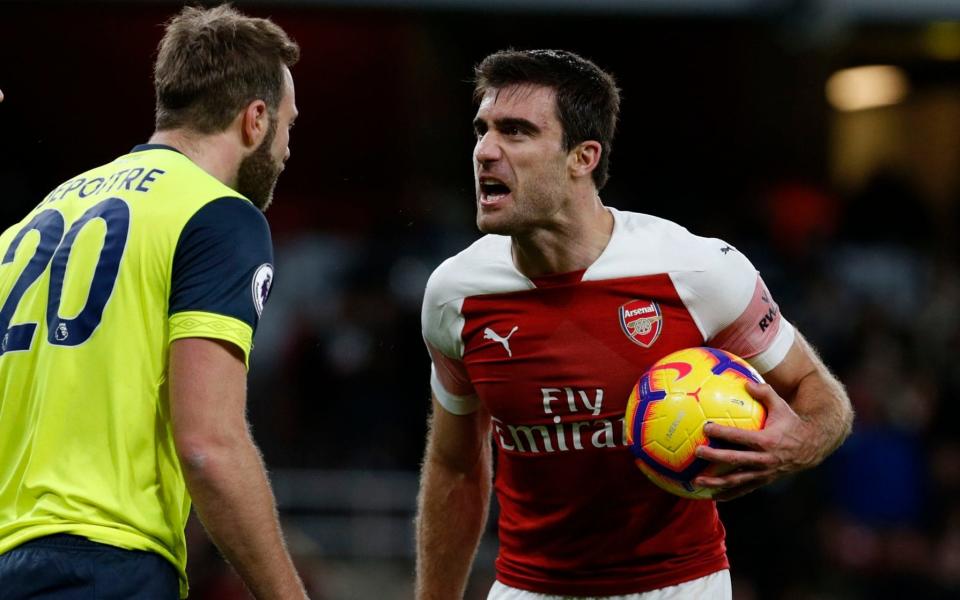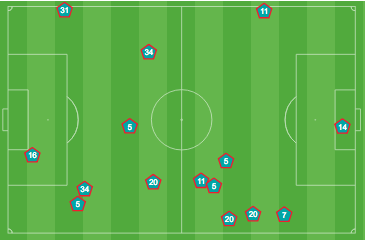How Arsenal rediscovered their bite and embraced the dark arts

Unai Emery's Arsenal earned a creditable seven points from fixtures against Tottenham Hotspur, Manchester United and Huddersfield last week, but also collected a startling 11 yellow cards.
Suspensions to Shkodran Mustafi and Sokratis give Arsenal a very real problem in the short-term, with ring-rusty Laurent Koscielny their only available centre-back for a trip to Southampton.
Three of the bookings against Huddersfield were for diving, a game in which Arsenal were on the receiving end of 21 fouls, but there will be those who welcome some bellicosity.
'Arsenal's red card SHAME' was once a staple headline in the early years of the Arsene Wenger era, when they made a habit of winning points with 10 men.
There were even stories, possibly apocryphal, of Arsenal training with 10 players such was the likelihood of a sending off.
Their reputation shifted dramatically post-2006, but are Arsenal shedding the condescending tag of 'neutrals' favourite' and becoming a team people love to hate again?
The numbers
The raw tackle and foul counts offer us a superficial view, but are not without interest.
Arsenal have made more tackles than any member of the Premier League's 'Big Six' this season, while only Manchester United have committed more fouls than Emery's team.
The 'Big Six' have been considered in isolation because they enjoy comparable levels of possession and territorial domination in most matches.
There is little point comparing Arsenal's defensive activity with Burnley or Cardiff's, because the teams have such different approaches and measures of success.
It is a slight surprise to see that Arsenal have conceded more fouls than Mauricio Pochettino's Spurs and Jurgen Klopp's Liverpool - two teams renowned for aggressive counter-pressing when they lose possession. Perhaps this hints at a slight change in approach from the current league leaders, who are far more comfortable defending in a shape and absorbing pressure since the signings of Virgil van Dijk and Alisson.
Manchester City are also known for ruthlessly cutting opposition counter-attacks at the knees, but they monopolise possession to such an extent the volume of their defensive work is reduced.
Indeed, it is no accident that the top six teams who have completed the most passes - City and Chelsea - have made the least tackles.
The numbers also cannot capture Arsenal engaging in snide moments of gamesmanship, in evidence during their 4-2 north London derby victory.
Arsenal substitutes Stephan Lichtsteiner, Aaron Ramsey and Matteo Guendouzi took exception to Eric Dier's 'shush' celebrations, suspecting that the England international was, in London parlance, 'taking liberties'.
Sead Kolasinac shoved Ben Davies in the chest, before Granit Xhaka lay on the floor laughing at a melee he had caused late on as Harry Winks stood over him spitting with rage.
It had Gary Neville purring: "It just felt like they had some nastiness about them today. Even when Eric Dier scored they went over and had a scrap with them over that. I like that. Arsenal teams haven't had a fight in them for years!"
The tactics
Any team that seeks to control possession and play in the opposition's half is vulnerable to counter-attacks. It has been a recurring nemesis for Pep Guardiola's teams, and the City coach devotes hours on the training pitch ensuring his team are positioned to stop them by fair means or foul.
Wenger's Arsenal rolled out the red carpet for opponents to run through them in transition all too frequently. A goal scored by Wayne Rooney for Manchester United in 2010, when Denilson was over-taken by the referee while 'tracking back', remains in the memory as a classic of the genre.
Emery still has work to do in this regard. Leicester, West Ham, Everton and Wolves all created big chances at the Emirates, with Arsenal grateful for some fine goalkeeping and clinical finishing to win points.
There has however, been a notable change of approach. Arsenal are making fewer interceptions than last season but making more tackles.
Under Wenger, it seems the defensive strategy was based on players holding their position, reading the game and looking to nip in front of opponents and steal the ball.
Now there is a slightly more pro-active approach under Emery, particularly in central midfield, with players encouraged to engage opponents directly.
Emery's Arsenal rely on their full-backs for width, so are susceptible to swift attacks that target the channels down the sides of their centre-halves.
This may be have been a factor in Emery's decision to switch to a back three. "When we are pushing with Hector Bellerin wide we need some players for balance," Emery said after victory at Bournemouth.
In the four games before this change in a 4-2-3-1, Arsenal conceded 10 'Big Chances' as defined by Opta. In the four matches with a back three, Arsenal have conceded just three 'Big Chances'.
Making fouls when both full-backs or wing-backs are caught upfield is a cynical, but effective, way of reducing the threat of the counter-attack.
Against Spurs, Arsenal's foul map shows a significant bias towards the right flank where they were attacking through the advanced Bellerin. As Bournemouth's equaliser and the break that led to Crystal Palace's second penalty show however, there remains room for improvement.
Arsenal's foul map vs Spurs, kicking from left to right.

New players
Arsenal retain elements of their attacking style under Wenger and many of the same players, but one key change is Lucas Torreira's presence in midfield. His arrival has given Arsenal more balance, and the Uruguayan's bite and snap in the challenge certainly pass the eye test.
Arsenal's other summer signings also seem to be strong characters who relish a scrap. The merits of signing Lichtsteiner and Sokratis will continue to be debated - there is a strong argument that Arsenal should have targeted funds at younger, long-term options. Borussia Dortmund spent the money they received from the Sokratis transfer on 22-year-old centre back Abdou Diallo, for example.
Lichtsteiner looks very much like the back-up option he is, but Sokratis' turn of pace has surprised some and he has not let Emery down. The Greek defender enjoys one-against-one duels and is known to fist-pump sliding tackles in celebration.
Matteo Guendouzi exudes authority well beyond his 19 years, and this preciousness seems to get under the skin of opponents. There a similarities with Cesc Fabregas, who quarrelled with Sir Alex Ferguson, Mark Hughes, Frank Lampard and Hull City in his youth at Arsenal.
It is impossible to quantify the impact new arrivals have on a squad's culture, and intangibles like 'character' play a marginal role in deciding results at best, but there does seem to be a pattern in Arsenal's summer recruitment.

